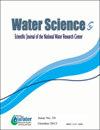Using groundwater quality index for categorizing the groundwater suitability for irrigation in the south Nile Delta region, Egypt
Q2 Environmental Science
引用次数: 0
Abstract
Groundwater is considered one of the most important sources of water all over the world. It can be used for different purposes of life, depending on its quality. The quality can be categorized for irrigation based on many items such as sodium percentage, permeability index (PI), magnesium hazard (MH), Kelley ratio (KR), and water quality index (WQI). Those items can be expressed and presented in Geographic Information System (GIS) format. This study aims to compare the WQI with the other items for expressing the suitability of groundwater for irrigation in GIS format. This study is conducted in the south Nile Delta region, Egypt. Seventy-two groundwater samples are collected and analyzed for pH, EC, total dissolved solids, soluble cations and soluble anions, iron, and manganese. These parameters are used to calculate the WQI considering their permissible limits of FAO, while the other items were calculated using some parameters based on their equations. The results reveal that, due to sodium percentage, there are three orders from five orders, of which 53% are good, 39% are permissible, and 8% are doubtful. Considering PI, the results were 7% for class 1 and 93% for class 2. Regarding MH, the results ranged between 6% (not suitable for irrigation) and 94% (suitable for irrigation). Depending on KR, 82% of the samples are suitable for irrigation, while 18% are not suitable for irrigation. The results of WQI illustrate that 76.4% of the total studied samples are excellent for irrigation and 23.6 are good for irrigation. All the results are represented using ArcGIS 10.1 program to clear the spatial distribution of the groundwater suitability for irrigation. The use of WQI with GIS is considered the best tool to represent and categorize the suitability of groundwater for irrigation.利用地下水水质指标对埃及南尼罗河三角洲地区地下水适宜灌溉进行分类
地下水被认为是世界上最重要的水源之一。它可以用于不同的生活目的,这取决于它的质量。根据钠含量、渗透指数(PI)、镁危害(MH)、凯利比(KR)、水质指数(WQI)等多种指标,可以对灌溉水质进行分类。这些项目可以用地理信息系统(GIS)格式表示和呈现。本研究的目的是将WQI与其他在GIS格式下表达地下水灌溉适宜性的项目进行比较。本研究是在埃及南尼罗河三角洲地区进行的。收集并分析了72个地下水样本的pH值,EC,总溶解固体,可溶性阳离子和可溶性阴离子,铁和锰。这些参数用于考虑粮农组织允许的极限来计算WQI,而其他项目则根据其方程使用某些参数来计算。结果表明,由于钠含量的原因,5个订单中有3个订单,其中53%为合格,39%为允许,8%为可疑。考虑PI, 1类为7%,2类为93%。对于MH,结果在6%(不适合灌溉)和94%(适合灌溉)之间。根据不同的KR, 82%的样品适合灌溉,18%的样品不适合灌溉。WQI分析结果表明,76.4%的研究样本适合灌溉,23.6%的样本适合灌溉。利用ArcGIS 10.1软件对所有结果进行表示,明确了地下水适宜灌溉的空间分布。WQI与GIS结合使用被认为是表示和分类地下水灌溉适宜性的最佳工具。
本文章由计算机程序翻译,如有差异,请以英文原文为准。
求助全文
约1分钟内获得全文
求助全文

 求助内容:
求助内容: 应助结果提醒方式:
应助结果提醒方式:


